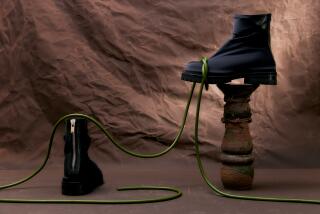Beauty, Italian Style : Fashion-Forward Italy May Be the Next New Force in Upscale Cosmetics
- Share via
FRENCH DESIGNERS have a longstanding reputation for creativity, but it is the Italians who are now emerging as cutting-edge fashion leaders. And because French houses have had enormous success in Europe and the United States with cosmetics lines--notably Chanel, Christian Dior and Yves Saint Laurent--it seems logical that the next new source of high-fashion makeup will be Italy. Some industry watchers are betting that names like Gianfranco Ferre, Giorgio Armani and Gianni Versace--the designers responsible for Milan’s trend-setter image--will soon grace American makeup counters. Others believe that Italian cosmetics with no famous fashion ties could be the next big trend.
Although none of the big-name Italian designers have released cosmetics collections yet, Ferre, Armani, Versace, Krizia and Fendi are already in the lucrative business of perfuming America. And trends in makeup emanate from Italian runways each season.
Italy’s own upbeat economy is ripe for upscale cosmetics, and small companies are springing up in Rome and Milan, registering big sales. Only a few, however, have so far been brave enough to aggressively invade the U.S. marketplace. The strategy is much like the designer-clothing approach: Export only the best at prices that connote prestige.
Terme di Saturnia is an example. The skin-care collection, introduced last year at the Doral Saturnia International Spa Resort in Miami, now sells for $25 to $125 at Saks Fifth Avenue, Nordstrom and Neiman-Marcus.
Although many American and French beauty products are manufactured in Italian factories, Estee Lauder and Lancome are the leading brands in Italy’s profumerias, the stores where perfumes and cosmetics are sold.
“Historically, the Italians felt less sophisticated than the French--or even the Americans--when it came to fashion, so upper-class snobbism forced stores to import makeup,” says Audrey Butvay, president of the Saturnia’s New York distribution firm.
“Italy simply has not had quality cosmetics that were domestically produced,” she continues. So until recently, the Italian image--not Italian product--has been sold in the United States. Instead, American firms offer makeup and treatments with Italian- sounding names.
The name Princess Marcella Borghese, for instance, is licensed by Revlon and the collection is developed in New York City. Trucco, a high-fashion makeup line sold in beauty salons, is a division of Sebastian International, the Woodland Hills-based hair-care firm.
Pupa and Diego de la Palma are two Italian lines that sell successfully in Italy and are also marketed in the United States. Pupa, sold in stores such as New York’s Bloomingdale’s, offers unusual makeup kits that sell for as much as $200. But Pupa is considered a gift item rather than a full-scale cosmetics line. And Diego de la Palma is available in “very limited quantity” at Bloomingdale’s, according to a store spokesperson.
The true test of Italian makeup may come soon. Armani is scheduled to open his Emporio Armani in Los Angeles next year, and industry observers expect him to offer a signature cosmetics collection. Ferre may enter the market even sooner with a line that is ready but has not been released. “The success of Italian style,” Butvay says, “has paved the way for Italian cosmetics.”
Stylist: Laura Kahn






